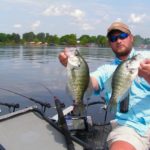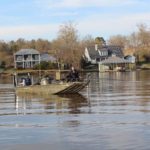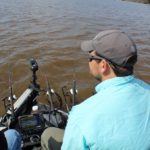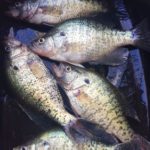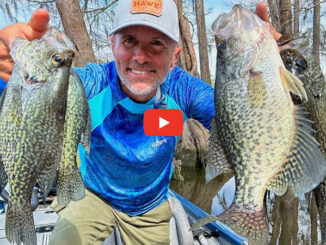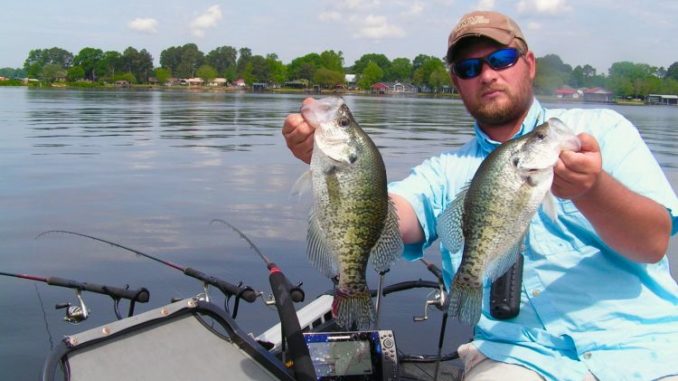
Contrary to popular belief, there is life after the spawn for Louisiana’s crappie anglers. Here’s how the reigning state champ gets it done all summer long.
“The fish have it backwards when it comes to the weather,” Nick Young said as he cruised his big Ranger down the edge of the boat channel, scanning his electronics for suspended crappie.
“In the winter and early spring, when it’s really cold, the fish bite best here on Lake D’Arbonne early in the morning and late in the evening — so we have to get cold to catch them,” he said. “Now when it starts getting hot in June and through the summer, they like to bite best in the middle of the day — when it’s hot as blue blazes.”
After making a couple of trips in both conditions with Young, who is a full-time crappie guide and the reigning Louisiana State Crappie champion, it’s a small price to pay for catching some slabs.
He is the only full-time crappie guide on Lake D’Arbonne, a 16,000-acre lake in Union and Lincoln parishes that is consistently ranked in the Top 10 crappie lakes in the country. The time he spent growing up on the lake, and now guiding, makes him uniquely qualified to stay on fish all year long.
“A lot of people think that when the spawn is over and the fish leave the shallow water, it’s all over until the fall or winter when they begin to congregate around shad schools in the deep water again,” he explained. “That isn’t the case.
“When the spawn is over, it takes the fish a few weeks to get over the stress, but they move out to the same staging areas they were in before they spawned. That is usually in 10 to15 feet of water on flats. And they like to hang out close to the stumps and timber. That’s where the shad go. And the crappie start gorging themselves again to get back into good shape after the spawn.”
Target the flats
By the time the hot summer rolls around, the fish are easy to pattern in those areas — and are easy to catch because they’re hungry again.
Young’s approach is to spider rig the stumpy flats, moving about .75 to 1 mph with shiners for bait. He fishes 4 to 5 feet deep, sometimes even shallower.
“What happens is that during the bright sunny part of the day, the shad will try and get in the shade of the timber — and that’s where the fish go, too,” he said. “The fish are more aggressive, so shiners work best because they are moving and incite the fish’s aggression.”
He likes to hook them through the lips so they can swim freely.
Like any other time, finding the fish is the first and most important objective. Young spends time scanning the flats with his Lowrance sonar or side-imaging units to find fish and baitfish. But if you don’t have that, he suggests just going back to the flats where you or other anglers caught fish pre-spawn. Stay in 10 to15 feet of water near the timber or stump fields.
“The are in transition areas on flats near creeks or sloughs,” he said. “They are a bit more scattered, but they are definitely in the timber. And the hotter, the better. That goes against a lot of traditional crappie thinking, but when it is so hot you can barely stand it, that’s when they’ll be biting.
“And up until late August when the heat may start to stress them a bit, the fish are healthy and in good shape.”
Flats are flat
A “flat” is just what it sounds like — a fairly flat area of the lake with only minimal depth variations. They may be 7 feet or 15 feet deep, but depth varies little until you reach a bordering channel, slough or dropoff. Because of the consistent depth, crappie and baitfish hold tight on structure like timber or tops.
Spider, man
Young fishes 14-foot Jenko rods which have a strong backbone and a fast tip. He uses Mr. Crappie baitcasting reels lined with 8- to 10-pound test line because in this application, they are easier to use than spinning reels and most clients are familiar with how to use them.
He also has his Ranger boat set up with two seats on the front deck, where he puts his clients while he runs the boat with a remote control trolling motor.
“D’Arbonne is just a fabulous lake,” he said. “It’s got big crappie and lots of medium and smaller fish. You won’t catch a 3-pounder here, but there are loads of 1-pound, 1 ½-pound and 2-pound fish.
“I fish a lot of lakes and I’d just as soon be here as anywhere.”
Young said if you are just fishing for fun, you can use shiners around the stumps to fish with just a single pole, or one pole in each hand. You probably won’t catch as many fish, but a lot of people enjoy feeling the bite, not just seeing the end of the pole dip.
Go “long” for more slabs
He also uses another fairly new technique to Louisiana — long-lining. Long-lining is setting up poles in the back of the boat, letting out line and basically trolling. You don’t long-line with shiners, but use artificials like curly-tail grubs or Road Runners. Chartreuse colors work best, but anything with pink or chartreuse is good on D’Arbonne, he said. And unless the fish are really tearing it up and you don’t need them, Young also uses chartreuse Crappie Bites on his hooks to add a little extra incentive while long-lining.
Lake D’Arbonne crappie fishing has received unprecedented attention in recent years because of the American Crappie Trail and Crappie Masters tournaments there, the only two major professional tournaments held in Louisiana. The 2019 ACT National Championship will be on D’Arbonne March 28 through 30.
Tournament fishing and guiding are both hard work, but guiding has it’s own pressures. It’s one thing to go fishing yourself and try and catch fish, but letting somebody else pay you to take them fishing takes it to a whole new level.
Young admitted it’s worse to take somebody fishing on a guided trip and not catch many fish than it would be for him to be in a big tournament and not catch any fish. But it happens to the best of fishermen, including guides, some of the time. Fortunately for Young, it doesn’t happen often.
“My objective every trip is to catch fish and have fun,” the 28-year-old Farmerville native said. But not all guided trips are just to catch a mess of fish. Many people who hire him are coming in for a week-long trip, and hire him to help them figure out the current pattern on the lake. Others are looking for instruction on different types of baits, techniques and how to learn to use electronics for crappie fishing.
Either way, it’s fine with Young. He’s just glad to be involved with fishing, whether it is sharing his knowledge with other anglers or being on the water catching fish.
You can get in touch with him at 318-243-8646 or by messaging him on Facebook at D’Arbonne Lake Guide Service.
